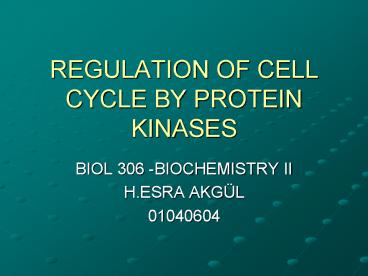REGULATION OF CELL CYCLE BY PROTEIN KINASES - PowerPoint PPT Presentation
1 / 21
Title:
REGULATION OF CELL CYCLE BY PROTEIN KINASES
Description:
REGULATION OF CELL CYCLE BY PROTEIN KINASES BIOL 306 -BIOCHEMISTRY II H.ESRA AKG L 01040604 References: LEHNINGER PRINCIPLES OF BIOCHEMISTRY www.biop.ox.ac.uk www ... – PowerPoint PPT presentation
Number of Views:1522
Avg rating:3.0/5.0
Title: REGULATION OF CELL CYCLE BY PROTEIN KINASES
1
REGULATION OF CELL CYCLE BY PROTEIN KINASES
- BIOL 306 -BIOCHEMISTRY II
- H.ESRA AKGÜL
- 01040604
2
References
- LEHNINGER PRINCIPLES OF BIOCHEMISTRY
- www.biop.ox.ac.uk
- www.biochemj.org
3
SUBJECTS
- AN INTRODUCTION
- CELL CYCLE
- IMPORTANCE OF PROTEIN KINASES
- LEVELS OF CYCLIN DEPENDENT PROTEIN KINASES
OSCILLATES - CRITICAL PROTEINS IN CDKs REGULATE
4
- Cell division requires a ordered sequence of
biochemical events that assures every daughter
cell a full complement of molecules required
for life. - Control of cell division in eukaryotic cells
have revealed regulatory mechanisms. - Protein kinases and protein phosphorylation are
central to the timing mechanism that determines
entry into cell division and ensures orderly
passage through
5
Cell cycle
6
Phases
- S PHASEDNA is replicated to produce copies for
both daughter cells. - G2 PHASENew proteins are synthesize and the cell
double in size - M PHASE (MITOTIC)maternal nuclear envelope
breaks down,paierde chromosome are pulled to
opposire of cell and cytokinesis ,producing two
daughter cell - G1 PHASEThe waiting period of again dividing.
- G0 PHASE Ceases phase,entering the quiscent.If
cell starts to divide,it reenters to G1 .
7
IMPORTANCE OF PROTEIN KINASES
- The timing of the cell cycle is controlled by
protein kinases with activities that change in
response to cellular signals. - By phosphorylating of proteins,protein kinases
the metabolic activities to produce cell division.
8
WHAT IS CDKs?
- The kinases are heterodimers with a regulatory
subunit, cyclin, and a catalytic subunit,
cyclin-dependent protein kinase (CDK). In the
absenceof cyclin, the catalytic subunit is
virtually inactive.When cyclin binds, the
catalytic site opens up, aresidue essential to
catalysis becomes accessible
9
Cdk2 structure
10
- CDK activities show striking oscillations
- These oscillations are the result of four
mechanisms for regulating CDK activity - 1-phosphorylation or dephosphorylation of the
CDK, - 2- controlled degradation of the cyclin subunit,
- 3-periodic synthesis of CDKs and cyclins,
- 4-the action of specific CDKinhibiting proteins.
11
Regulation of CDks by phosphorylation
- The activity of a CDK is strikingly affected by
two critical residues in the protein - Phosphorylation of Tyr15 near the amino
- terminus renders CDK2 inactive the P Tyr
residue is - in the ATP-binding site of the kinase, and the
negatively - charged phosphate group blocks the entry of ATP.
A - specific phosphatase dephosphorylates this P Tyr
- residue, permitting the binding of ATP.
- Phosphorylation of Thr160 in the T loop
of CDK, forces the T loop out of the substrate
binding cleft, permitting substrate binding and
catalytic activity.
12
(No Transcript)
13
Controlled degradation of cyclin
- Progress through mitosis requires first the
activation then the destruction of cyclins A and
B, which activate the catalytic subunit of the
M-phase CDK. These cyclins contain near their
amino terminus the sequence ArgThrAlaLeuGlyAs
pIleGlyAsn, the destruction box, which
targets them for degradation.The DBRP(destruction
box recognizing protein.) recognize this protein.
14
- UbiquitinCyclin and activated ubiquitin are
covalently joined by the enzyme ubiquitin ligase - Several more ubiquitin molecules are then
appended, providing the signal for a proteolytic
enzyme complex, or proteasome, to degrade cyclin.
15
The feedback mechanism
- Increased CDK activity activates cyclin
proteolysis. Newly synthesized cyclin associates
with - and activates CDK, which phosphorylates and
activates - DBRP. Active DBRP then causes proteolysis of
cyclin. - Lowered cyclin causes a decline in CDK
activity, and - the activity of DBRP also drops through slow,
constant - dephosphorylation and inactivation by a DBRP
phosphatase.The cyclin level is ultimately
restored by synthesisof new cyclin molecules.
16
Regulated Synthesis of CDKs and Cyclins
- CyclinD, cyclin E, CDK2, and CDK4 are synthesized
only when a specific transcription factor, E2F,
is present in the nucleus to activate
transcription of their genes. Synthesis of E2F is
in turn regulated by extracellular signals such
as growth factors and cytokines
17
Inhibition of CDKs
- Specific protein inhibitors bind to and
inactivate specific CDKs. One such protein - is p21.
18
Critical proteins
19
- How does the activity of CDK control
- the cell cycle?
- BehindCDK regulation by inspecting the effect of
CDKs on the structures of laminin and myosin and
on the activity of retinoblastoma protein. - pRb when DNA damage is detected, this protein
participates in a mechanism that arrests cell
division in G1
20
- Breakdown of the nuclear envelope before
segregation of the sisterchromatids in mitosis is
partly due to the phosphorylationof laminin by a
CDK, which causes laminin filaments to
depolymerize. - After the division, CDK phosphorylates a small
regulatory subunit of myosin, causing
dissociation of myosin from actin filaments and
inactivating the contractile machinery
21
- When pRb, is phosphorylated,itcannot bind and
inactivate EF2, a transcription factor that
promotes synthesis of enzymes essential to DNA
synthesis. If the regulatory protein p53 is
activated by ATM and ATR, protein kinases that
detect damaged DNA, it stimulates the synthesis
of p21, which can bind to and inhibit cyclin
ECDK2 and thus prevent phosphorylation of pRb.
Unphosphorylated pRb binds and inactivates E2F,
blocking passage from G1 to S until the DNA has
been repaired.































